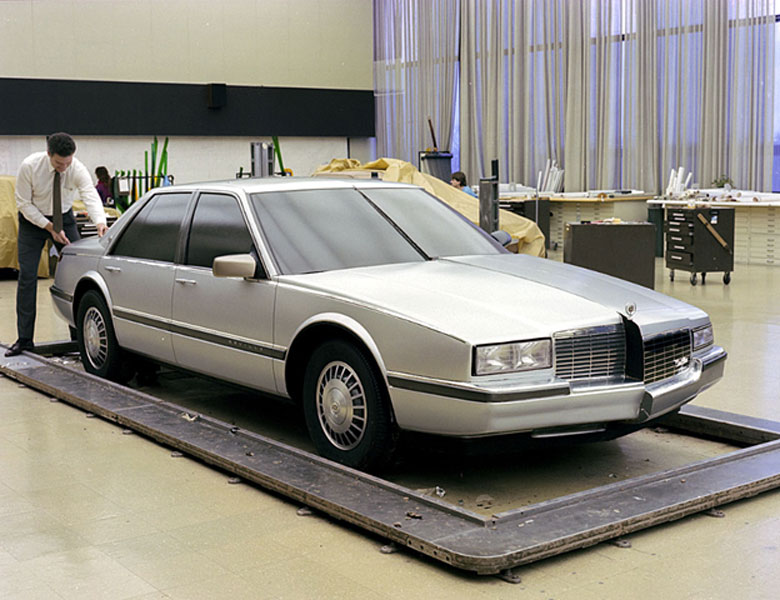
Cadillac Studio made an early presentation to Cadillac management showing that the added length by Cadillac Engineering was still not enough to arrive at a proportion that would result in a good design for the Seville and Eldorado. The proposed extensions added rear seating space and luggage capacity that also resulted in lower aerodynamic drag that improved fuel economy, higher than the shorter 1986 Seville. A more design enhancing and functional package was the result of the additional length. The proposed extensions, shown on the left side front and rear, added more rear seating space and luggage capacity. The longer car also resulted in significantly lower aerodynamic drag resulting in improved fuel economy, helping to make the 1992 Seville higher in fuel economy than the shorter 1986 Seville. The new more design enhancing and functional package was the result of the additional length to be added front and rear as seen on the left side of the clay model.
By Dick Ruzzin
Photos courtesy GM Design Archives
Cadillac Studio had won the battle with Pininfarina for the Eldorado design, but earlier, when the production release dates came for both the Eldorado and the Seville, we had missed them, which was a financial disaster for the Corporation. There is an enormous stream of work to design and engineer the full line of GM products so when one program gets out of phase from a timing standpoint the pre-production development process suffers delays that are very costly.
FINALLY, THE “RIGHT CAR”
In addition to being late, we did not have the design for either car. To everyone’s amazement we then created an entire new Seville design in twelve days, one that would later become a big winner in the corporate product clinics. The effort was like a very good artist practicing for two years and then making a single fantastic painting in a flash. Only it wasn’t a painting, it was a car designed and created by a group of over twenty people in a frantic coordinated burst of creativity.
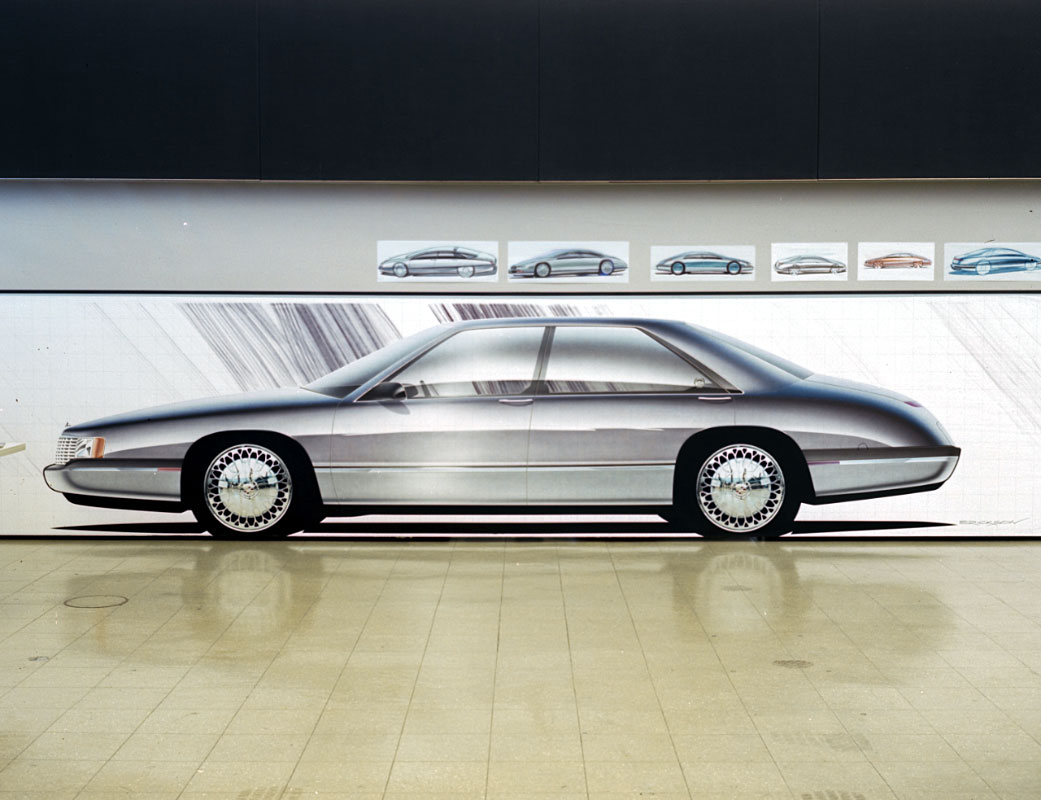
This quick side view rendering by Dennis Little was corrected in the rear to come close to what we would end up with on the Seville. His next rendering where he raised the top of the doors became the turning point for the Seville design search. It was then transferred to a clay model where Larry and Scott actually airbrushed the design shape onto the clay model surfaces.
Our Design Engineering supervisors gave up their full year’s vacation and worked overtime seven days a week to release the Seville, as the outside contractor proved to be incapable. For the Eldorado and the Seville, the Cadillac Studio twice worked 24 hours for over three days in a row to meet the new release deadlines. We had a lot of help from other sculptors and engineers in the building and we divided the studio staff into two teams to manage the workload. Design management was providing every available resource to win the war against time.
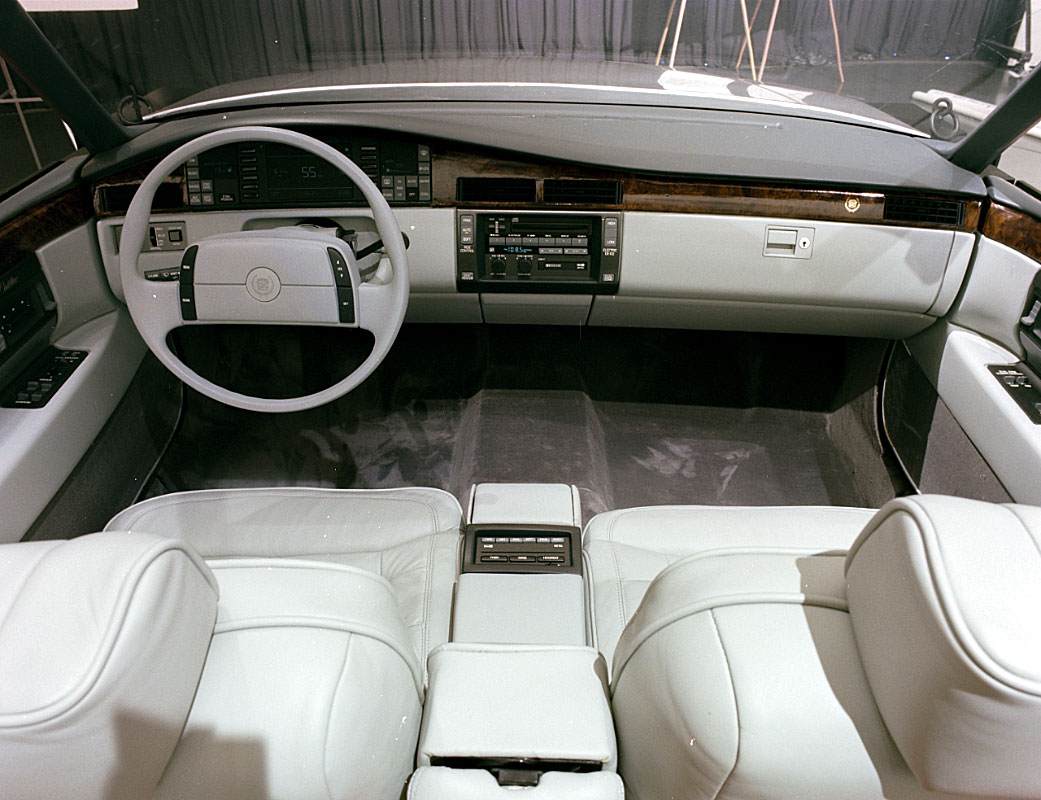
While the Cadillac Exterior Studio was struggling to find a design for both the Eldorado and the Seville the Interior Design Studio under the direction of Chief Designer Marv Fisher worked to create an interior that would match the different versions of both cars. Sporty and elegant, the result was a beautiful clean and contemporary interior that had excellent ergonomics. Designer Jeff Nasca created the instrument panel theme that matched the two cars perfectly. The instrument panel hood that curved up and over the instruments gave the cars a driver orientation and a special feel of stability when moving as its reference to the horizon was always correct.
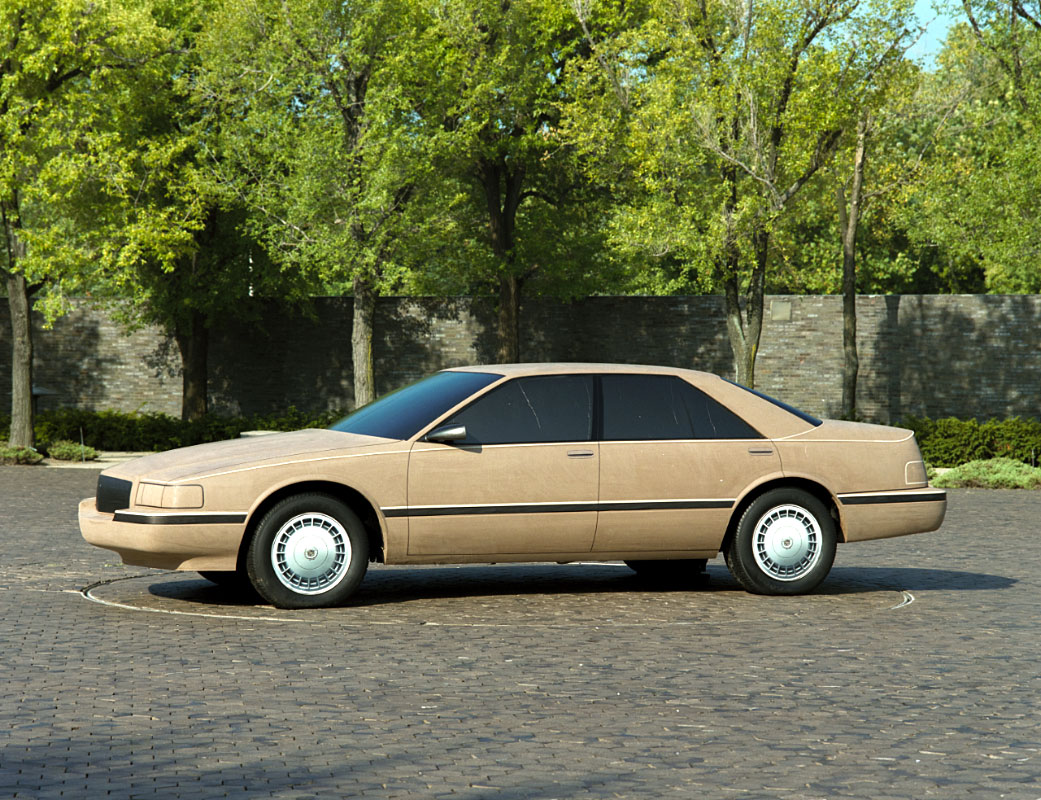
The last trip to the Design patio for the clay model of the 1992 Seville design before being released for production. The final data from the windtunnel tests had been included on this release model. This was the last chance to make any design refinements or changes and to match the criteria for door cuts, wheel clearance and ride height. It was late in the afternoon and usually Design management would show up just to add more eyes to the party but this time they skipped the show. We did not work overtime that night for the first time in over two years.
THE ELDORADO DESIGN
In two weeks, we had created another Eldorado, in another flash. It was unlike any proposal previously done but it did have some design features from our past work that was skillfully knit together by the Cadillac designers over a period of four days. We released the car as fast as possible but we were one month late. The new design started on an existing outdated fiberglass model, put together with paper, pins, plastic, tape, cardboard and whatever else, to represent the new design. We showed it to the Cadillac management the following day in the morning in the Cadillac Studio. We had the model covered and when the cover was pulled there was a very large intake of breath by the entire Cadillac team. They absolutely loved it.
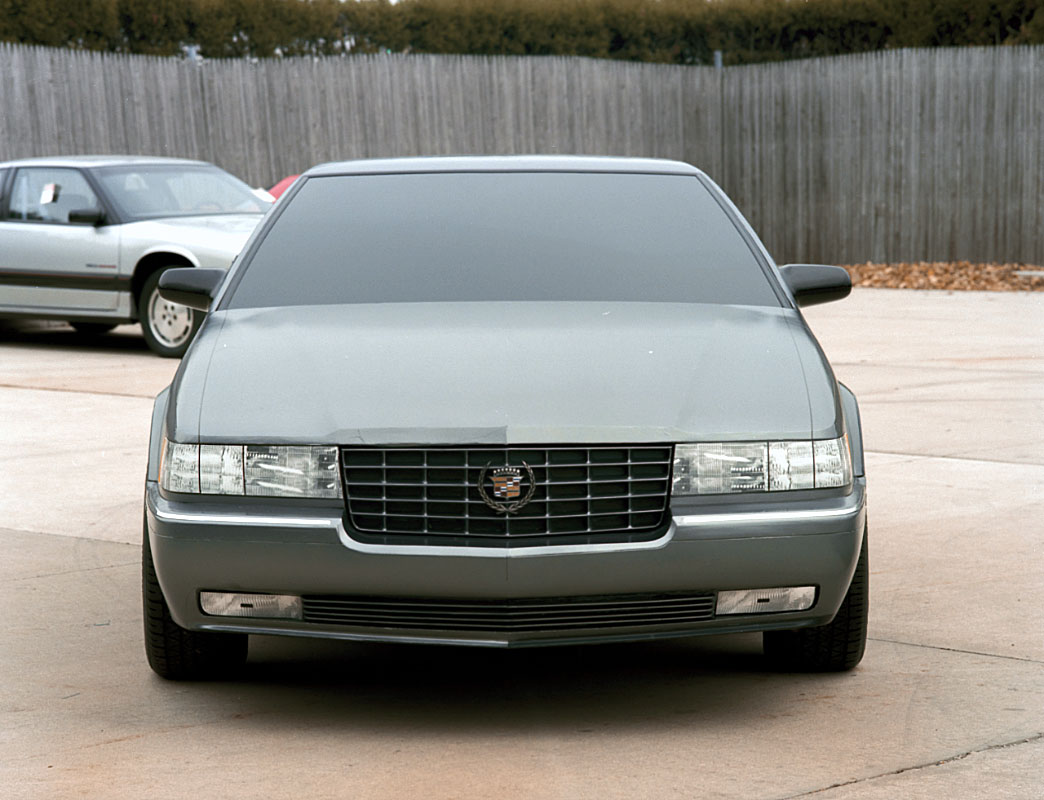
The front end of the Cadillac STS (Seville Touring Sedan). What the car was about was not a mystery. Larry Erickson, Scott Wassell and Gary Smith created the STS in two days while I was in the windtunnel. Again, they used paper and tape to design a clean and simple statement on the Seville fiberglass model that was in perfect harmony with the high performance luxury mission of the STS. A visual statement of sporty elegance, the hot-rod Cadillac engineers were ecstatic!
We were flying on fumes as we prepared the model for an outside show late that afternoon. We made some minor adjustments, brought it back into the studio and then spent several days on corrections and refinements. It was sent to the plaster shop to be cast and then returned to the studio. Normally clay models are damaged in the plaster casting process but this time we were lucky. We made some minor repairs, added more refinement and then released it for production in two weeks.
Did we work hard? We all worked harder than we ever had in our lives. Thousands of aesthetic decisions were made in a matter of a few short days. The car was so good because a lot of people worked very, very hard. Cadillac was so happy they did not care that we were late. Both the Eldorado and the Seville were big winners in the upcoming Corporate product clinic and later in the market. The result was worth it.
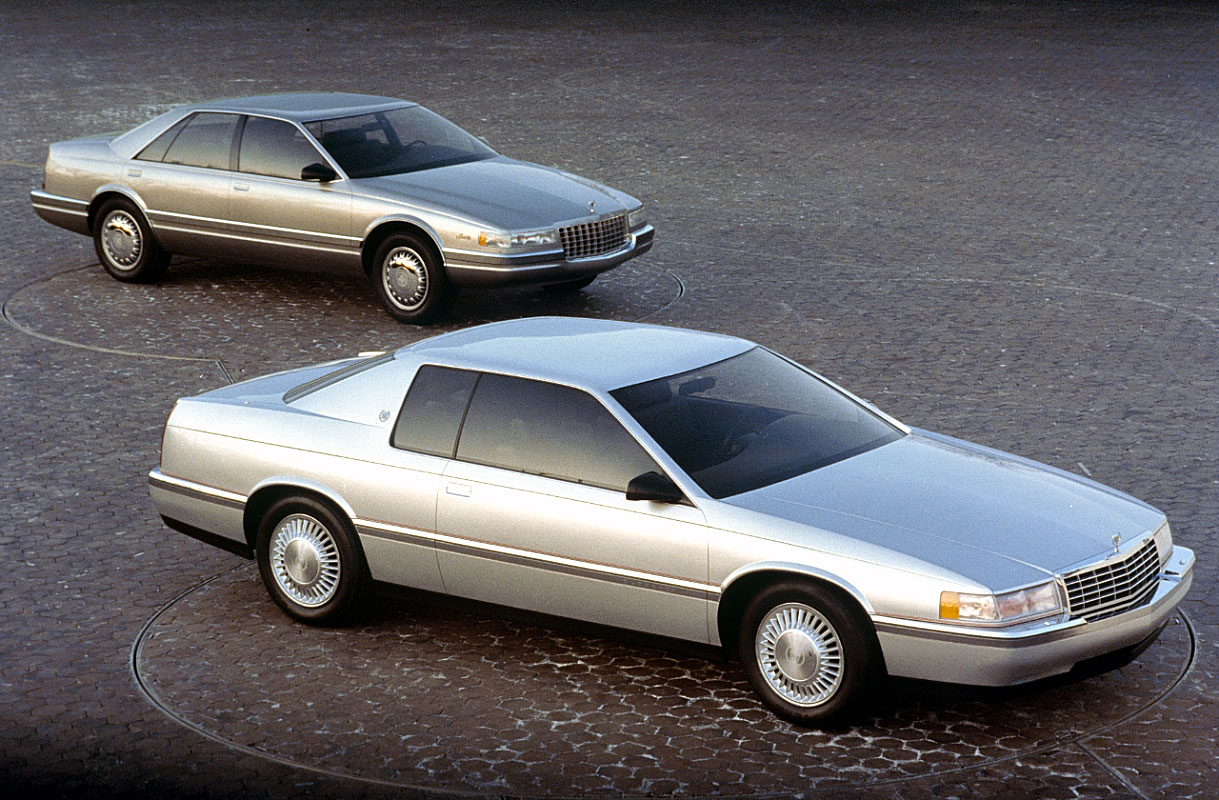
My favorite picture, the one and only shot of the Eldorado and Seville together taken after the GM Corporate product clinic where they received very high marks. Although they shared many different components, even some on the exterior, that did not hamper our desire for each to be visually unique. Cadillac received everything that they hoped for and our designs were carried on a chassis that was every bit as good as the design. Henry Meier, Chief Engineer for the Eldorado and Seville said, “Design has done their job, now we must do ours.” And they did in spades, engineering two wonderful contemporary luxury cars that surprised the European manufacturers with their driving prowess.
THE SEVILLE
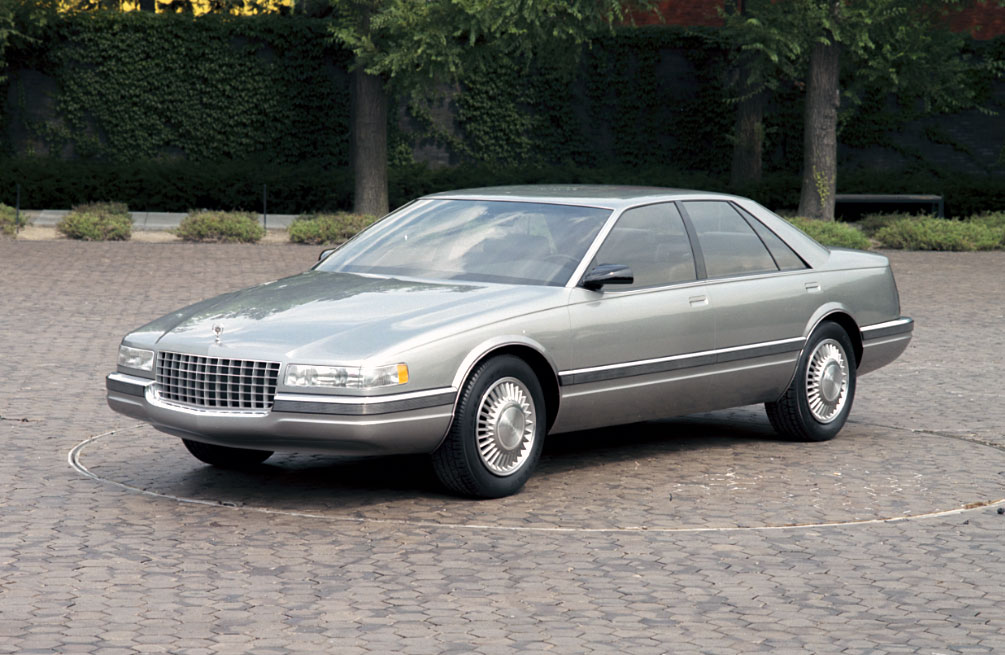
The 1992 Seville fiberglass model taken in GM Design Staff’s secure reviewing patio. The Seville was designed as an import fighter and Cadillac Engineering matched its sporty and elegant look with advanced technologies, superb internationally inspired performance and fuel economy. Aerodynamics was important in its design as the Seville’s drag coefficient was very low at .33, a key factor in the increase in fuel economy.
One day the Vice President of Cadillac, John Grettenberger, came into the studio. He stopped and looked at the clay model of the Seville that was being released for production and said,” It is already a classic in my mind”. That was his way of giving a great compliment to all of us. Over twenty-five years later Dan Neil, then the auto writer for the Los Angeles Times, declared that the 1994 Seville STS was a modern classic. All four of the major car magazines named the Seville as the Car of The Year, a historic first. The yearly Motor Trend contest for most desirable new car that was traditionally won by the Chevrolet Corvette went to the Cadillac Seville for two years in a row.
THE ELDORADO
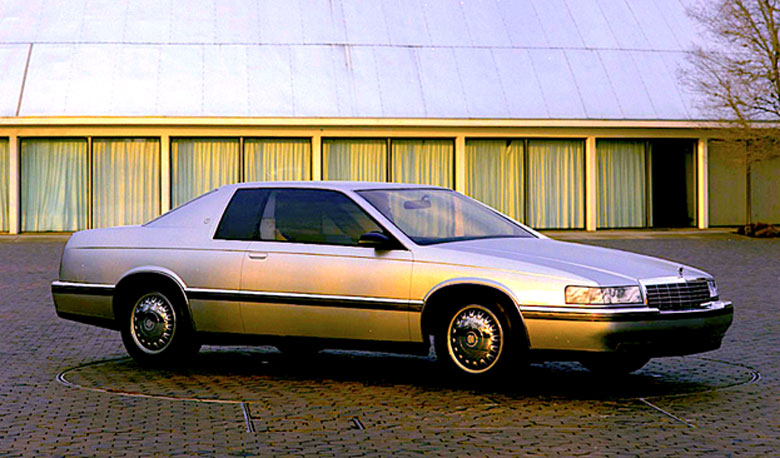
Looking very different than the Seville, with gently curving surfaces and taught lines, the Eldorado moved away from the then current rounded design look of the day. It presented a new futuristic aesthetic of horizontal longitudinal lines linked by transverse rounded sections that were more subtle than the Seville. The combination proved to result in excellent aerodynamic numbers due to the simplicity of the surfaces and rounded plan views.
When the Cadillac Eldorado was introduced at the Detroit International Automobile Show in Detroit in January of 1992, I was standing near the display when the Chief Designer of Lincoln came up to me and introduced himself. He looked at the car for a moment and then said, “Come on over to the Lincoln stand and see our Continental, it really looks new”, intimating that the Eldorado did not look new. He did not understand that the Eldorado had been designed to be ahead of and beyond the “Ford trendy and round” design envelope. The Lincoln was not and three years later no-one would bother looking at a Lincoln Continental.
Not so the Eldorado. It was very successful and the number of orders for the car were so strong and steady that its production was continued for twelve years. Most were built at a plant in Detroit only four miles from my home. I lived close to and had met several of the people who ran the plant and I was told that it was the longest running production car in General Motors history. The way it looked was a big factor in that success.
THE LIGHT
When our full-size Eldorado clay model was taken out to our secure viewing patio for the one and only outside review, a very strange thing happened. Normally a production car model is taken out many times before the design is released for production to improve and refine it, but our time was gone. It was December, dark, damp and cold, the temperature was about 30 degrees. There was salt on the patio blocks and we waited and shivered in the chill wind for our moving staff to bring the model out. It was five o’clock and starting to get dark. The sky was lead gray and having the clay model in silver did not enhance it in that lighting. We always covered our clay models before they went out as the winter cold would cool the clay too quickly and make it crack, a real problem when you are working in clay to a one tenth of a millimeter tolerance. As the car was rolled out of the building to my great surprise it was not covered.
As soon as we saw the model we were all elated. For the first time in two years we had a design in front of us that met the Cadillac Studio design expectations and it looked better outside in the real world. We, the Cadillac designers, really liked it. And so did Chuck Jordan and Dave Holls who we were responsible to.
It was getting dark, being December, and about 5pm the sun was very low on the horizon in the west. Suddenly a brilliant light hit our clay model in a very small spot in the middle of the door. I looked immediately to the right to see where it was coming from. There was a large bright yellow light in the streaked and glowing western sky; it must have been thousands of miles away. A small slit in the clouds had opened up and the light shot through, yet the light on the car was very small. I had never seen anything like that before.
Although it was a strange event it did not stand out at the time as it was in company with so many others. It was just another one that passed by as we were so happy to finally arrive at an Eldorado design that pleased all of us.
Needless to say, the two-year fury of activity took its toll on all of us. We did 17 fully-finished clay model proposals for the Seville and Eldorado in 21 months and released two cars for production as well as substantial facelift work on the rest of the Cadillac line including a Presidential limousine. We also created the first Seville STS on the old smaller platform that was a big success in California.
I could not speak about what we had done for two years as Chief Designer of Cadillac after I left Cadillac Studio and on a new assignment at Opel Design in Europe. Success in the creation of the new Eldorado and Seville was an incredible achievement that almost did not happen. When questioned about the Cadillac designs over two years later, even after being assigned to work in Europe, I had to just walk away until the subject was changed. The years of constant emotional stress were just too much for me to bear, I am sure others felt it too. Through all of it our Design management acted like one of us, we all worked together as equals. We also had without question the best studio staff in the building, every person performed beyond expectations. It was flat out, all out, for over two years.
This story is all true to the best of my memory thirty-three years later. I have written it to honor the members of the Cadillac Studio and all those from Design who came to help as well as the studio staffs who worked in the Advance Design area who definitely were part of our eventual success.
Bob Dorn, Cadillac’s new Chief Engineer from Pontiac Division, was appointed shortly before I was sent to Cadillac Studio. He made many key decisions that favored our design efforts as he believed that the appearance of the two cars had to be exceptional. He and his engineering team created light weight cars with elegant performance that matched our designs, proved by the many awards that they received for their engineering excellence. Of special importance to him was the strategic roll-out of new technologies for Cadillac so that when the 1992 cars arrived they would be state of the art. He did what had to be done even to the expense of his own career.
Very special credit should be given to my studio management, Dennis Little, my Assistant Chief Designer, our Chief Sculptor Ray Hildebrandt and Bill Mullaly, our Studio Engineer. Marv Fisher, who was Chief Designer for Cadillac Interiors, did an absolute superb job in crafting an interior that perfectly matched the sporty elegance of the exteriors for the two cars. Also to be mentioned are the many people from Cadillac Division who watched as we struggled to succeed and were encouraging and very helpful, many going above and beyond their responsibility. Hank Meier, the Eldorado and Seville Chief Engineer throughout the entire program, was encouraging, trusting and patient and we all worked hard to help him every way that we could. Everyone contributed at a very high level over a very long and trying period of time. It is the reason that we succeeded; all of the dedication and perseverance made the difference. We did not give up as a group. We did not give up as individuals. All through the trying time, Len Casillo, Dave Holls and Chuck Jordan guided us and never lost faith in our ability to succeed.
I’m a 75 yrar old architect who’s been driving for 60 years. I bought my first STS in 1998. It was a 1994 in dark metallic green with a peanut butter interior. I thought it was a beautiful design and loved the way it drove. It had 94,000 miles on it when I bought it and I added 150,000 more. I only sold it because I found a 2003 STS in Crimson Pearl with only 7,000 miles on it. To me this is the perfectly designed car. It’s simple beauty, perfect ergonomics and wonderful handling are an unbeatable combination. While I prefer the original 1992 exterior, the later cars have better instrumentation and controls. No video game touch screens for me. I even sold my 2003 Corvette because I found I enjoyed driving the STS more because of the better ergonomics.
My thanks to Mr. Ruzzin and his crew for so many enjoyable miles.
My whole life, I’ve loved and admired Italian cars for their designs. Never considered myself a Cadillac man – until I fell in love with and purchased a black 1992 Eldorado. It looked so handsome, elegantly proportioned, intelligent… everything I sought in a car’s shape. Soon after, I also fell in love with a Forest Green 1993 Seville STS which I bought for my wife. We were both enamored of its shape, and she especially loved the Northstar engine’s power. I couldn’t get over how roomy and comfortable it was for being so low to the ground. Both cars grew on us even stronger over the years – if not for accidents at the hands of others, I’d probably still have both and still think about looking for a good used one now… That’s the mark of a true classic, when you’d rather have one despite it’s age than ‘settle’ for something newer.
Thanks for the great article Dick!